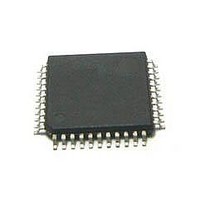E-TDA7437N STMicroelectronics, E-TDA7437N Datasheet - Page 25

E-TDA7437N
Manufacturer Part Number
E-TDA7437N
Description
Multimedia Misc CNTRL audio PROCESSR
Manufacturer
STMicroelectronics
Type
Audio Processorr
Datasheet
1.E-TDA7437N.pdf
(34 pages)
Specifications of E-TDA7437N
Maximum Operating Temperature
+ 85 C
Minimum Operating Temperature
- 40 C
Mounting Style
SMD/SMT
Package / Case
TQFP-44
Lead Free Status / RoHS Status
Lead free / RoHS Compliant
Available stocks
Company
Part Number
Manufacturer
Quantity
Price
TDA7437N
5.8
The type (stereo/mono) of received broadcasting signal is easily checked and displayed by
using the ST bit.
The P bit check is useful in tuning jumps without signal muting.
The SM soft mute status becomes active immediately, when bit D0 is set to 1 (soft mute ON,
MUTE byte) and not when the signal level has reached the 60 dB final attenuation.
TDA7437N I
The protocol is standard I
Chapter
The optional autoincrement mode allows to refresh all the bytes registers with transmission
of a single subaddress, reducing drastically the total transmission time.
Without autoincrement, subaddress bit I = 0, to refresh all the bytes registers (10), it is
necessary to transmit 10 times the chip address, the subaddress and the data byte.
Working with a 100Kb/s clock speed the total time would be :
[(9*3+2)*10]bits*10us=2.9ms
Instead using autoincrement mode, subaddress bit I=1, the total time will be:
(9*12+2)*10us=1.1ms.
The autoincrement mode is useful also to refresh partially the data. For example to refresh
the 4 speakers attenuators it is possible to program the subaddress Spkr LF (code
XX010100), followed by the data byte of SPKR LF, LR, RF, RR in sequence.
Note: that the autoincrement mode has a module 16 counter, whereas the total used
register bytes are 10.
It is not correct to refresh all the 10 bytes starting from a subaddress different than
XX010000.
For example; using subaddress XX010010 (volume), the registers from Volume to Mute (see
Table
wanted Input selector, and Loudness are discharged. (the solution in this case is to send
two separate patterns in autoincrement mode, the first composed by address, subaddress
XX010010, 8 data bytes, and the second composed by address, subaddress XX010000, 2
data bytes).
With autoincrement disabled, the protocol allows the transmission in sequence of N data
bytes of a specific register, without the necessity to resend the address and subaddress
bytes, each time.
This feature can be implemented, for example, if a gradual volume change has to be
performed (the MCU does not send the STOP condition, but keeps the TDA7437N
communication active).
5) are correctly updated, but the next two transmitted bytes, refer instead to the
Warning:
4).
2
C bus protocol
The TDA7437N always needs to receive a STOP condition,
before beginning a new START condition. The device doesn't
recognize a START condition if a previously active
communication was not ended by a STOP condition.
2
C, using subaddress byte plus data bytes (as shown within
Mute and pause features
25/34














